RogueRose
International Hazard
    
Posts: 1585
Registered: 16-6-2014
Member Is Offline
|
|
MIRACLE sealing & moulding material - make stoppers, bungs, plugs etc
So I needed a way to seal a glass jar to a metal pie plate as the jar had a hose barb and could hold full vacuum. I wanted to heat the material
inside so I used an old pie pan and found this weatherstrip caulking cord at the hardware store. for $6 I got like 45ft of this stuff. It is kind of
like really sticky clay and silly putty mix. Kind of like that tack you use to hang posters or whatever on the wall. I've used it to seal a 1/4"
glass tubing inside a 24/40 opening and it worked perfectly. It handles heat to at least 325F and I'm testing it at 400 and 550 later today.
If you ever need to use a coffee grinder or blender or even ball mill where dust makes it's way out of tiny cracks, this stuff is great to put along
the edge and seal it. it's reusable over and over and never seems to loose it's stickyness though it can be a little difficult to get off after it
has been heated on glass.
So, just thought this might be useful to some of you. I was watching that show "moonshiners" where they all seem to use oatmeal paste to seal all the
copper piping (seems a little staged that they all use the same thing this day of age..) and this stuff works much better.
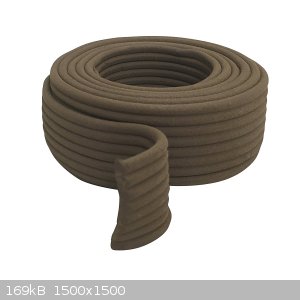 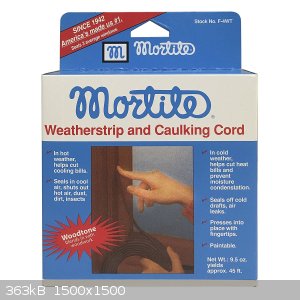
|
|
|
sodium_stearate
Hazard to Others
  
Posts: 255
Registered: 22-4-2011
Location: guard duty at the checkpoint
Member Is Offline
Mood: No mask.
|
|
Brilliant! Thanks for that. This is a great example of finding common materials to accomplish very specialized tasks.
Often, when such substitutions are found and used, the
result is perfectly workable, and at a fraction of the cost
of specialized material or equipment.
"Opportunity is missed by most people
because it is dressed in overalls and it
looks like work" T.A. Edison
|
|
|
aga
Forum Drunkard
    
Posts: 7030
Registered: 25-3-2014
Member Is Offline
|
|
Nice find.
In many places it would be hard to find that material, so a bit of clay or wet oatmeal works pretty well.
Depends on how few $ you wanna spend.
If a material costs $0 (like some wet dirt) it does not matter if it can be re-used, as there is more free dirt to be had.
|
|
|
Dr.Bob
International Hazard
    
Posts: 2656
Registered: 26-1-2011
Location: USA - NC
Member Is Online
Mood: No Mood
|
|
Plumber's putty would be very similar. There are other sealants that might work also, but whatever works is fine.
|
|
|
RogueRose
International Hazard
    
Posts: 1585
Registered: 16-6-2014
Member Is Offline
|
|
Using the sealant for various purposes
I've used it to make condensers from 2 pipes, a copper inner pipe and a PVC outer shell. I made sure all pipes were dry and then packed this material
in between the two pipes to about .5" - 1" thick and then I drilled a hole in the PVC, stuck a vinyl hose into it and sealed it with this "putty" and
it worked for at least 40+ hours until I pulled it apart. It never failed until I pulled it apart.
Another use was to make a make-shift still from 2 1L glass media bottles, 2 media culture tubes (like test tubes) , a 4ft fluorescent light tube
(glass). I cut holes in the culture tubes so the light tube would fit inside very tightly - I did this with a diamond blade on my Dremel (one of the
best, if not the best tool in my toolbox by far!!!) I used the caulking to seal each joint on the culture vial as well as the base of the vial where
it pressed against the top lip of the glass media bottle, making a perfect seal. It worked great for distilling EtOH and HNO3!
This vial is the perfect diameter to seal on top of any glass media bottle that takes the GL45 cap/lid and that caulking makes a perfect seal and
takes about 4-6lbs to pull off once pressed on.
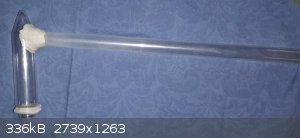
I made a long "snake" of the putty and lined the hole in the vial and pressed it in the middle of the cut so 1/2 was inside of the vial and the other
half was outside. Pressing the light bulb through made contact with the putty and sealed perfectly and I then pressed it to make more contact on the
areas and added more putty on the outside to build up the joint. I did this on both sides of the condenser the vapour and condensate side.
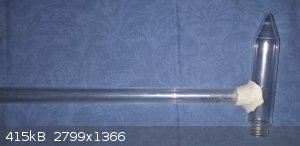
This is the basic distillation setup with the source bottle in the back (I used a hot water bath, oil bath, sand bath or heat gun to heat the bottle)
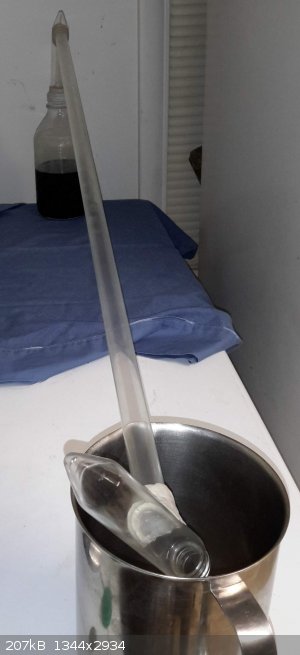 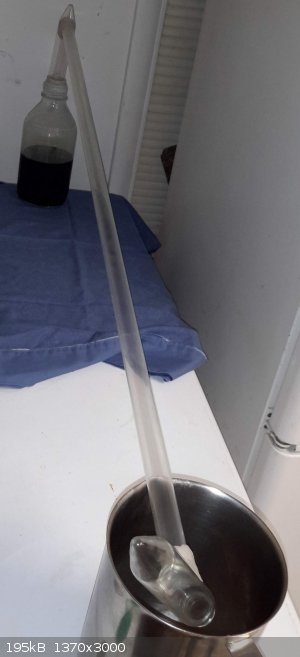
You can see the putty holding the vial onto the bottle and it is even more clear in the picture on the right
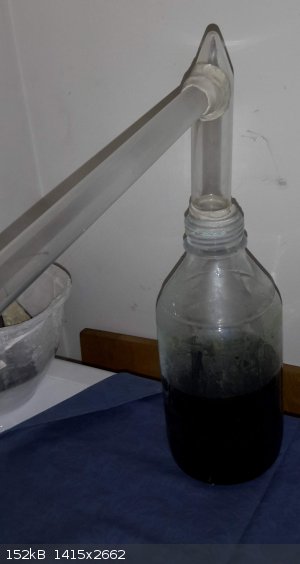 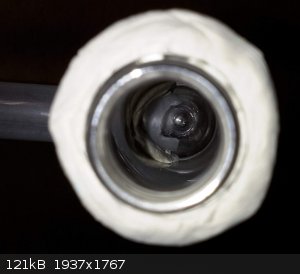
This is the condensate output so there is no putty on this end, though it could be added if the material were volatile.
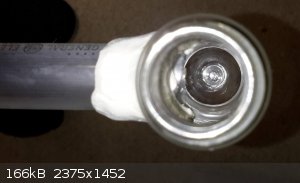
A second setup of distilling some of the HNO3 off. Notice a little extra putty on the joints, with the condenser being so long, there is a lot of
torque when things move so I wanted to ensure that there was no breakage or leakage if things were moved.
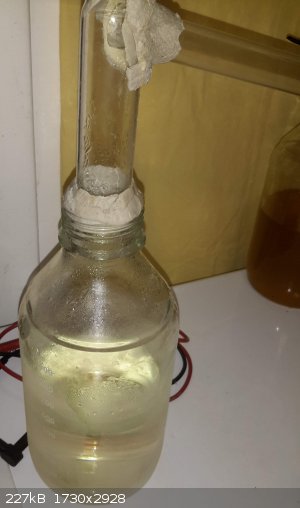
This is a modified filter top to allow for different configurations of vacuum, daisy chaining vacuum and can be used as a receiving cap (pulling
filtered liquid into the bottle) or as the source bottle/cap. The hose barbs are from the local plumbing store and are vinyl fittings (which may not
be the best choice but it is the only choice other than brass which is more expensive and much less options). The hose clamp around the bottle neck
is to allow it to be suspended from a stand over a flame or hot air gun or other heat source and it has worked really well with these bottles thought
I haven't tried temps over 550F and I always made sure to change temp slowly.
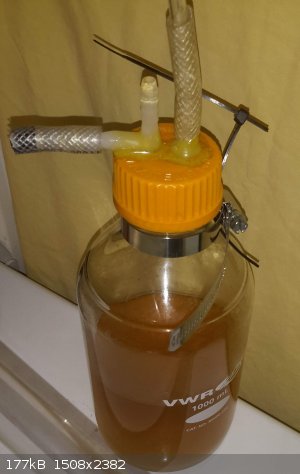
These are the vacuum chamber device I made with a 1/4" brass hose barb (cut with diamond dremel bit - LOVE IT!!) and then the putty used to make a
perfect seal on the bottom of the steel pie plate. I guess I could use aluminum as well but the ones I had were larger and this just fit perfectly.
I'm planning on getting some thermoelectric generators and should be able to get a 120w unit which is a lot of hear for such a small area - though it
is controllable for less heat if desired.
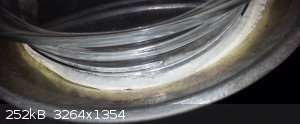 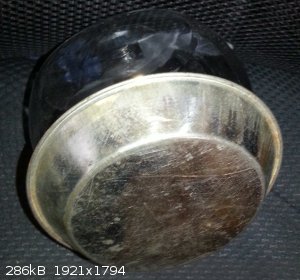 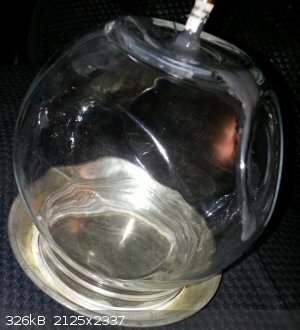 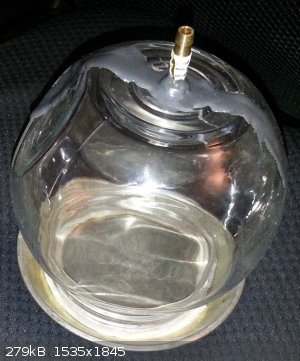
I was able to run a number of distillations until I turned the heat up a little too much and the condenser cracked. It just popped during a HNO3
distillation. I had a squirrel cage fan pulled from a microwave blowing across it towards the collection point and it did an excellent job of
removing heat from the glass that I could get a steady trickle of liquid coming out. I'd say it rivaled some small water condensers I've used in the
past but I can safely say there is no substitute for the real thing and I'd really like to learn glass blowing and learn how to make some of these
items.
Well I hope someone might be able to use some of these ideas or maybe it sparks an idea somewhere. Good luck and have fun!!!
|
|
|
Melgar
Anti-Spam Agent
    
Posts: 2004
Registered: 23-2-2010
Location: Connecticut
Member Is Offline
Mood: Estrified
|
|
I was hovering over the "report spam" button for a second there. 
Personally, I use silicone glue, hot glue, and heavy duty epoxy the most for sealing stuff. Silicone takes about a day to dry, but forms a strong
bond to just about everything. Epoxy is less flexible and durable, and smells like sulfur so I can't use it on anything that's going to use a
palladium catalyst, but it sets in about ten minutes, so that works out well. Of course, hot glue is super cheap and hardens the fastest, but the
bond isn't strong to a lot of materials. That, and it doesn't hold up to heat and the glue gun takes a while to warm up.
Personally, I've found a lot of uses for bits and pieces of plastic and rubber tubing that ends up left over from stuff. If you want to create a
makeshift stopper that can allow for a tight seal between a piece of tubing (glass or stiff plastic) and the neck of a bottle, just cut a bit of
latest tubing and fit it about a third of a 3 cm piece of latex tubing over the end. Then turn the end of the latex tubing inside out, and pull it
back up so it overlaps itself most of the way.
The first step in the process of learning something is admitting that you don't know it already.
I'm givin' the spam shields max power at full warp, but they just dinna have the power! We're gonna have to evacuate to new forum software!
|
|
|